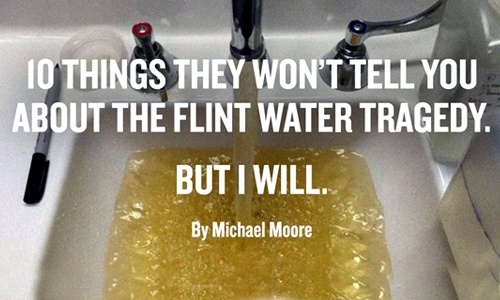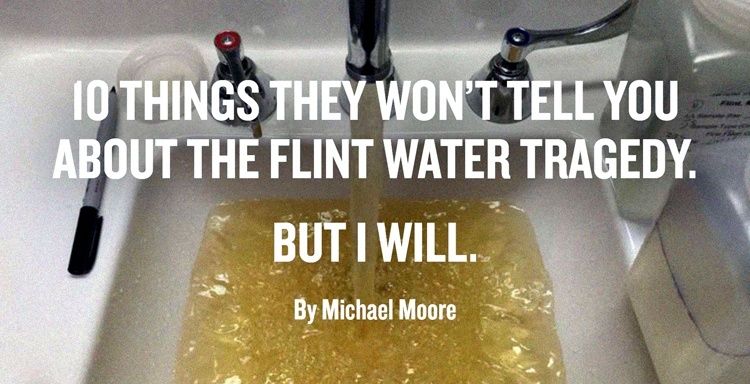
Michael Moore: 10 Things They Won’t Tell You About the Flint Water Tragedy, But I Will

News of the poisoned water crisis in Flint has reached a wide audience around the world. The basics are now known: the Republican governor, Rick Snyder, nullified the free elections in Flint, deposed the mayor and city council, then appointed his own man to run the city. To save money, they decided to unhook the people of Flint from their fresh water drinking source, Lake Huron, and instead, make the public drink from the toxic Flint River.

When the governor’s office discovered just how toxic the water was, they decided to keep quiet about it and covered up the extent of the damage being done to Flint’s residents, most notably the lead affecting the children, causing irreversible and permanent brain damage. Citizen activists uncovered these actions, and the governor now faces growing cries to resign or be arrested.
Here are 10 things that you probably don’t know about this crisis because the media, having come to the story so late, can only process so much. But if you live in Flint or the State of Michigan as I do, you know all to well that what the greater public has been told only scratches the surface.
1. While the Children in Flint Were Given Poisoned Water to Drink, General Motors Was Given a Special Hookup to the Clean Water.
A few months after Gov. Snyder removed Flint from the clean fresh water we had been drinking for decades, the brass from General Motors went to him and complained that the Flint River water was causing their car parts to corrode when being washed on the assembly line. The governor was appalled to hear that GM property was being damaged, so he jumped through a number of hoops and quietly spent $440,000 to hook GM back up to the Lake Huron water, while keeping the rest of Flint on the Flint River water. Which means that while the children in Flint were drinking lead-filled water, there was one—and only one—address in Flint that got clean water: the GM factory.
Long before helping Flint, Michigan officials were shipping clean water to their own workers https://t.co/wbrKxkVAvo pic.twitter.com/OCZfVgQXBM
— Mother Jones (@MotherJones) January 30, 2016
2. For Just $100 a Day, This Crisis Could’ve Been Prevented.
Federal law requires that water systems which are sent through lead pipes must contain an additive that seals the lead into the pipe and prevents it from leaching into the water. Someone at the beginning suggested to the governor that they add this anti-corrosive element to the water coming out of the Flint River. “How much would that cost?” came the question. “$100 a day for three months,” was the answer. I guess that was too much, so, in order to save $9,000, the state government said f*** it—and as a result the State may now end up having to pay upwards of $1.5 billion to fix the mess.
3. There’s More Than the Lead in Flint’s Water.
In addition to exposing every child in the city of Flint to lead poisoning on a daily basis, there appears to be a number of other diseases we may be hearing about in the months ahead. The number of cases in Flint of Legionnaires Disease has increased tenfold since the switch to the river water. Eighty-seven people have come down with it, and at least ten have died. In the five years before the river water, not a single person in Flint had died of Legionnaires Disease. Doctors are now discovering that another half-dozen toxins are being found in the blood of Flint’s citizens, causing concern that there are other health catastrophes which may soon come to light.
4. People’s Homes in Flint Are Now Worth Nothing Because They Cant Be Sold.
Would you buy a house in Flint right now? Who would? So every homeowner in Flint is stuck with a house that’s now worth nothing. That’s a total home value of $2.4 billion down the economic drain. People in Flint, one of the poorest cities in the U.S., don’t have much to their name, and for many their only asset is their home. So, in addition to being poisoned, they have now a net worth of zero. (And as for employment, who is going to move jobs or start a company in Flint under these conditions? No one.) Has Flint’s future just been flushed down that river?
5. While They Were Being Poisoned, They Were Also Being Bombed.
Here’s a story which has received little or no coverage outside of Flint. During these two years of water contamination, residents in Flint have had to contend with a decision made by the Pentagon to use Flint for target practice. Literally. Actual unannounced military exercises—complete with live ammo and explosives – were conducted last year inside the city of Flint. The army decided to practice urban warfare on Flint, making use of the thousands of abandoned homes which they could drop bombs on. Streets with dilapidated homes had rocket-propelled grenades fired upon them. For weeks, an undisclosed number of army troops pretended Flint was Baghdad or Damascus and basically had at it. It sounded as if the city was under attack from an invading army or from terrorists. People were shocked this could be going on in their neighborhoods. Wait—did I say “people?” I meant, Flint people. As with the governor, it was OK to abuse a community that held no political power or money to fight back. BOOM!
6. The Wife of the Governor’s Chief of Staff Is a Spokeswoman for Nestle, Michigan’s Largest Owner of Private Water Reserves.
As Deep Throat told Woodward and Bernstein: “Follow the money.” Snyder’s chief of staff throughout the two years of Flint’s poisoning, Dennis Muchmore, was intimately involved in all the decisions regarding Flint. His wife is Deb Muchmore, who just happens to be the spokesperson in Michigan for the Nestle Company—the largest owner of private water sources in the State of Michigan. Nestle has been repeatedly sued in northern Michigan for the 200 gallons of fresh water per minute it sucks from out of the ground and bottles for sale as their Ice Mountain brand of bottled spring water. The Muchmores have a personal interest in seeing to it that Nestles grabs as much of Michigan’s clean water was possible—especially when cities like Flint in the future are going to need that Ice Mountain.
7. In Michigan, from Flint water, to Crime and Murder, to GM Ignition Switches, It’s a Culture of Death.
It’s not just the water that was recklessly used to put people’s lives in jeopardy. There are many things that happen in Flint that would give one the impression that there is a low value placed on human life. Flint has one of the worst murder and crime rates in the country. Just for context, if New York City had the same murder rate as Flint, Michigan, the number of people murdered last year in New York would have been almost 4,000 people—instead of the actual 340 who were killed in NYC in 2015. But it’s not just street crime that makes one wonder about what is going on in Michigan. Last year, it was revealed that, once again, one of Detroit’s automakers had put profit ahead of people’s lives. General Motors learned that it had installed faulty ignition switches in many of its cars. Instead of simply fixing the problem, mid-management staff covered it up from the public. The auto industry has a history of weighing the costs of whether it’s cheaper to spend the money to fix the defect in millions of cars or to simply pay off a bunch of lawsuits filed by the victims surviving family members. Does a cynical, arrogant culture like this make it easy for a former corporate CEO, now governor, turn a blind eye to the lead that is discovered in a municipality’s drinking water?
The lead pipes in Flint are just a tiny part of a huge problem with lead-poisoning. https://t.co/LcGP7dR3y4 pic.twitter.com/jhlXn34YiY
— Slate (@Slate) January 30, 2016
8. Don’t Call It “Detroit Water”—It’s the Largest Source of Fresh Drinking Water in the World.
The media keeps saying Flint was using “Detroit’s water.” It is only filtered and treated at the Detroit Water Plant. The water itself comes from Lake Huron, the third largest body of fresh water in the world. It is a glacial lake formed over 10,000 years ago during the last Ice Age and it is still fed by pure underground springs. Flint is geographically the last place on Earth where one should be drinking poisoned water.
9. ALL the Children Have Been Exposed, As Have All the Adults, Including Me.
That’s just a fact. If you have been in Flint anytime from April 2014 to today, and you’ve drank the water, eaten food cooked with it, washed your clothes in it, taken a shower, brushed your teeth or eaten vegetables from someone’s garden, you’ve been exposed to and ingested its toxins. When the media says, “9,000 children under 6 have been exposed,” that means ALL the children have been exposed because the total number of people under the age of 6 in Flint is … 9,000! The media should just say, “all.” When they say “47 children have tested positive,” that’s just those who’ve drank the water in the last week or so. Lead enters the body and does it’s damage to the brain immediately. It doesn’t stay in the blood stream for longer than a few days and you can’t detect it after a month. So when you hear “47 children,” that’s just those with an exposure in the last 48 hours. It’s really everyone.
10. This Was Done, Like So Many Things These Days, So the Rich Could Get a Big Tax Break.
When Gov. Snyder took office in 2011, one of the first things he did was to get a multi-billion dollar tax break passed by the Republican legislature for the wealthy and for corporations. But with less tax revenues, that meant he had to start cutting costs. So, many things—schools, pensions, welfare, safe drinking water—were slashed. Then he invoked an executive privilege to take over cities (all of them majority black) by firing the mayors and city councils whom the local people had elected, and installing his cronies to act as “dictators” over these cities. Their mission? Cut services to save money so he could give the rich even more breaks. That’s where the idea of switching Flint to river water came from. To save $15 million! It was easy. Suspend democracy. Cut taxes for the rich. Make the poor drink toxic river water. And everybody’s happy.
Except those who were poisoned in the process. All 102,000 of them. In the richest country in the world.

 233k
233k  41k
41k  Subscribe
Subscribe 